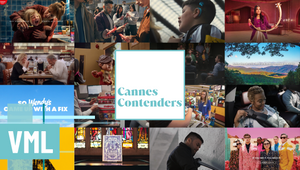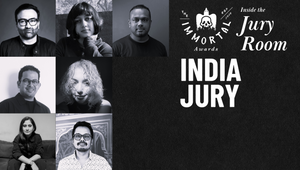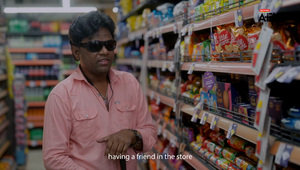
How India’s Art History Came to Life in a Moving Canvas

Across India, millions of vehicles hit the road every day, and the country’s number one automotive battery brand Exide wanted a campaign that would capture the scale and diversity of the country that it powers. And so the team at Wunderman Thompson South Asia has created a campaign that’s a treat for the eyes, drawing from India’s many rich artistic traditions.
The spot was conceptualised and directed by Arjun Mukherjee, senior ECD, and VP at Wunderman Thompson Kolkata, and brought to life by illustrator and animator Sourish Mitra. The whole project took months and started off with a deep dive into artistic cultures and styles across the country - Gond, Kalamkari, Thangka, Pithora, Patachitra, Ganjifa, Kalighat, Madhubani, Bastar, Miniature Painting, Bhil, Pichwai, Chittara, Warli, Kurmli Sohrai and a lot more. Recreating those styles to depict mopeds, minivans, buses, bikes, trucks, and tractors journeying across the country was a painstaking process in and of itself, but animating and editing them created an extra layer of complexity.
And while the film is a visual delight, it’s also an audio feast - musical director Subhajit Mukherjee wove together threads from various Indian musical styles to create a modern mix of traditional music.
The end result embeds Exide as the engine of India’s daily commute, while also showcasing how the country’s advertising industry is crafting its own visual vernacular. Arjun Mukherjee delves into the process.
LBB> What was the initial brief and strategy behind the campaign?
Arjun> Exide is by far the highest selling automotive battery in India. Most vehicles, two-wheelers or four wheelers, run on Exide. For us at Wunderman Thompson, who have been journeying with the brand for a very long time, we knew that it was important to bring out the impact and spread of the brand from an Indian perspective and give it the epic scale it deserves. If a vehicle is moving, the automotive battery gets forgotten, and so the bigger challenge was to create something memorable, an experience that sticks in the head, a brand that is remembered long after the show is over.
LBB> And how did that translate to the idea of depicting the daily life of modern India via different styles of folk art and folk-inspired modern art traditions?
Arjun> We wanted to create one unforgettable journey across the length and breadth of India. However, such is the culture, diversity, and span of this vast nation that there is no single thing that depicts this trippy milieu. Although weaved together as the idea of India, every state has it’s own intrinsic, identity and vibrancy. That’s when we hit upon the idea of using our rich, traditional, vibrant art forms to tell the story. Once we started researching this, no other treatment threw up as much vibrancy and excitement, and from then on there was no going back.
LBB> From a creative perspective, how did you find the process of researching the various art styles and immersing yourself in India's art?
Arjun> For Sourish and I, it was literally a trip down the rabbit hole. The further we went the more mind bending it became. The internet was the first step, then art books, visits to galleries, museums, and local fairs. The discovery phase was humbling as we found brilliance everywhere, on truck backs, village walls, handbills, block prints, cloth designs, calendars and so on. The material we curated had historical significance and was so detailed from a craft perspective that we took a lot of time to overcome our initial jitters before embarking on the first frame.
LBB> What were you trying to capture with the story?
Arjun> A gigantic country like India is connected by its unending network of roads, streets, lanes and by lanes. Every day, millions of vehicles ply on it to keep this nation moving. And what drives a majority of them is a battery that is hidden inside the vehicle. A heart that keeps beating to keep the country moving. On a broad level, we wanted to portray the epic task being performed day in and day out through a portrayal that is humongous as well. The scale was important to show the enormity of the task being performed. We wanted to bring people, states, cultures, traditions, art forms and musical renditions on a single endless canvas called India.
LBB> From a directing perspective, what were the most creatively satisfying and interesting challenges and how did you tackle them?
Arjun> We had to be sure which art form will look good on our canvas and what won’t. The imagery was in our heads but still, we had to try various renditions and then filter out the ones which didn’t quite fit. The experiment phase of the project was both exasperating and exhilarating. And even when we thought that we had chosen the right ones, at times it still didn’t work out when we tried stitching them together through cutaways and transitions. So, imagine re-imagining a traditional art form with vehicles and modern objects, painstakingly re-creating it, and then not using it. With each second, the film grew in length, the challenge increased and became more complex. So, attention to detail and ensuring that one frame fell into another seamlessly was the biggest challenge, and when that happened it was like a eureka moment for both Sourish and me.
LBB> This film has so much going on and I know that bringing it to life took over nine months - can you tell us about the painstaking process of creating the illustrations and bringing them to life?
So, after the research phase, we sat down to identify the styles that will fit in our film when we recreate the same with vehicles and cities in a modern setting. As with any creative process it was destroying, creating, and destroying again. We experimented with a whole lot of styles. After about three months we kind of got the pulse of the journey and started realising what would work for us. There was no science to it, just hunches and that worked. For Sourish to do and re-do each frame to get the composition right was a huge ask, and then he animated the whole film alone. From getting the form right to the movements right it was an enormous ask.
LBB> With so many styles of art to juggle, I imagine the edit was quite complex - what were the biggest challenges there?
Arjun> Honestly, we created a storyboard but then threw it away. Each completed frame gave us a new idea for the edit and transitions. Each morning we reviewed the film, a different idea on the edit evolved and then we started on a new journey. It was a freestyle, unplanned process and the confusion worked. The biggest challenge was to visually place one art form after another in such a way that although drastically different in style they had to look like a seamless part of one never-ending journey. The magical music by Subhajit Mukherjee blending a plethora of Indian styles and instruments, made us re-think the edit once more and honestly, we kept on editing since the last day. As the music grew on us we knew that the artwork needed more inputs and the pace and pattern of the edit needed change. Even today, if we could, we would have messed with the edit!
LBB> Sourish Mitra brought a lot to the campaign with illustrations and animations - how did you identify him as a talent to collaborate with and what did he bring to the project?
Arjun> Sourish is a brilliant illustrator who is one of the best in the country today. During the covid period, we started collaborating on short format animation ideas. Suddenly we saw our films winning all over the globe and realised that maybe we are doing something good. He is also a prolific book cover designer and I have seen him experimenting with different styles.
When this idea hit I knew it was an enormous task effort wise, but I was sure that style-wise he would pull it off. His dedication, temperament and range are so good that I am not surprised that he pushed this film to where it is now. Here I must also mention the music director, Subhajit Mukherjee as well. The ethno-fusion soundtrack drew inspiration from a wide range of Indian instruments like the Ravanhatta and Rabab to the Dotara and Dholak. The music amplified the art styles even more and helped in bringing India together beautifully.
LBB> How familiar are the people of India with these artists and traditions? Is it something that people are generally very well-versed in and proud of, or is it something that you're hoping to revive and celebrate and bring back to life for the 21st century?
Arjun> While art galleries are a very good reference point, the fact is that our entire country is a gigantic art gallery of traditional forms if one looks carefully. It’s there everywhere. From rickshaw backs, saree prints, house walls and heritage sites to village fairs, calendar art, ancient scrolls, and pottery, just to name a few. Maybe somewhere, it is in so much abundance that it has become a blind spot. Pride is there but over time a majority of us have forgotten to appreciate the inherent, crazy creativity that is out there. Artist and their crafts are getting overlooked. Our film is just a small effort to revive the interest In our rich heritage, and the appreciation it is getting just proves that maybe all we need to do is find interesting, fresh ways to present them.
LBB> Can you talk us through some of the artistic traditions and artists who have inspired this piece - I would love to know what else is going on!
Arjun> More than any artist we have kept to forms, traditions and geographies. Gond, Kalamkari, Thangka, Pithora, Pattachitra, Ganjifa, Kalighat, Madhubani, Bastar, Miniature Painting, Bhil, Pichwai, Chittara, Warli, Kurmli Sohrai, and more went into the final canvas. It blends time periods, religions, places, history, subjects, drawing styles, colour usage and surfaces. From mythology and nature to daily life and folk traditions each style had something to depict. Some of them date back thousands of years and honestly the exact time period is difficult to determine. As for Jamini Roy, he experimented in many styles, starting by taking inspiration from European masters but finally developing his own style that was inspired by Kalighat pats.
LBB> We have a global audience of artists and art directors, many of whom won't be so familiar with Indian folk art and modern art - how would you describe India's diverse artistic roots? And where should our readers start if they would like to learn more about India's artistic movements and traditions?
Arjun> Get on to the internet, to begin with, and enjoy this mind-bending experience. Discover how India has always been a culturally rich country with art, sculpture and architecture playing a significant role in every century. Indian art spans across civilizations and has survived multiple invasions and colonial conquests.
After you do that, put in some annual leave, pack your bags and visit India towitness the vibrancy, detailing and craziness for yourself. There’s too much to digest in one visit so maybe come again. No wonder some of us believe in the concept of reincarnation. Believe me, it takes more than one lifetime to experience everything, including the art.
LBB> What's really interesting about a lot of the Indian folk artists in the 20th century like Jamini Roy is that they were working to create a vernacular for Indian art that had its own identity and wasn't about drawing on western/colonial traditions - what can modern Indian advertising learn from this, especially as aesthetics become so homogenised across the world due to social media etc?
Arjun> Over time, advertising in India has gone desi with insights and instances which are intrinsic to our country, and we don’t blindly ape what’s going on elsewhere. As communication professionals, we have understood that there’s an infinite well of things in our daily life, history, and culture to attract people with and to which they can relate easily and quickly. Both idea and craft wise, work that has been inspired by India’s own insights and traditional art forms has won big in global advertising festivals as well. So, we are getting recognised with what is our own, both in India and globally. Today most of us, who are in Indian advertising sincerely believe that we can push the needle further and take India to the world even more.















